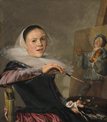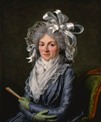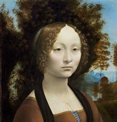









Large paintings
Images below are in chronological order and sized approximately to scale relative to each other. *Click images to enlarge*
1. Self-portrait
*Woman artist*
Artist: Judith Leyster, age about 21 (Dutch; born 1609, died 1660)
Medium: Oil on canvas, 29 x 26 inches
Location: Painted in the province of Holland in either Zaandam (near Amsterdam) or Haarlem
Time: Painted around 1630, during the Eighty Years War establishing Protestant Dutch Republic's independence from Catholic Spanish rule. Leyster painted this a few years before she became a member of Haarlem's Saint Luke's Guild. This piece may have been the work she submitted for entrance into the guild.
Woman subject: Leyster depicts herself painting in an impractical formal dress with a large white collar. This was a convention painters used to portray their art as culture rather than as craft.
Things to notice: The brush in Leyster's hand is echoed by the bow in the violinist's hand in the painting within the painting. The self-confident artist seems to be momentarily paused from her work to speak to a visitor in her studio. By depicting herself painting a "merry company" genre scene, Leyster is advertising her skills both as a portraitist and as a genre painter.
Additional information: Only one other woman was accepted into Haarlem's painters' guild in the 17th century. Leyster had her own workshop with paying pupils, which was unusual for a woman at that time. However, there were more women painters in northern Europe than in southern European countries. This was due in part to the spread of the Protestant Reformation in Northern Europe. Protestantism rejected religious iconography and turned to genre themes in art. These everyday subjects were more accessible to women artists.
2. Portrait of Madame de Genlis
*Woman artist*
Artist: Adelaide Labille-Guiard, age 29 (French; born 1749, died 1803)
Medium: Oil on canvas laid down on board, 29 x 24 inches
Location: Painted in Paris
Time: Painted in 1790, at the beginning of the French Revolution. Labille-Guiard was the official painter to Mesdames (the aunts of Louis XVI) and had an aristocratic clientele before the Revolution. After the Revolution she painted portraits of revolutionaries.
Woman subject: Stéphanie Félicité, comtesse de Genlis, was a popular French author of educational treatises. She achieved instant success with a four-volume series of plays written for her daughters, published 1779-1780. Genlis' employer (and lover), the duc of Chartres, made Genlis his daughters' governess. In 1782 she was promoted to governor, a highly unusual title for a woman, and taught the Chartres sons as well. At the same time Genlis began writing about the philosophy of education. Genlis is 44 years old in this portrait.
Things to notice: Labille-Guiard is known for the direct presentation of her subjects. She renders the details of Genlis' clothing without detracting from the individuality captured in her face. Notice how the color of Genlis' gloves is echoed in the color of the chair.
Additional information: Labille-Guiard's father owned a haberdashery next to the studio of miniaturist François-Élie Vincent. Her association with Vincent may have helped her overcome insitutional barriers to women artists. For instance, perhaps Vincent's influence as a Conseiller aided her acceptance into the Paris painters' guild. Only about three percent of the members were women in 1750-1800. Labille-Guiard became Vincent's pupil in 1776. She eventually established her own studio with her own students. She was admitted as a member of the Académie Royale in 1783 and fought for equal rights for women artists in the academy. She married Vincent in 1800. How do you think the fact that Labille-Guiard is a woman impacts her depiction of this successful woman author?
3. Eliza Welch Stone
Artist: Thomas Skynner, age unknown (American; birth and death dates are unknown)
Medium: Oil on canvas, 30 x 24 inches
Location: Possibly painted in Mohawk, New York.
Time: Painted around 1845
Woman subject: Eliza Welch Stone and her husband John Stone are believed to be from Mohawk, New York.
Things to notice: Skynner is an American (or possibly Canadian) Naïve portrait artist. Notice the foreshortened arm, the rubbery-looking hand, and the dotted eyelashes, all characteristic of Skynner's portraits. This is one of a pair of portraits. The other is of Eliza's husband John. Like Renaissance wedding portraits, these are intended to hang together with the husband at the left of the viewer and the wife at the right. Notice the background column at the left of this painting: the companion portrait of John Stone includes the rest of the column. View the pair of portraits together (both images courtesy the National Gallery of Art, Washington).
4. Miss Mathilde Townsend
Artist: John Singer Sargent, age 51 (American; born 1856, died 1925)
Medium: Oil on canvas, 60 x 40 inches
Location: Painted in Washington, D.C.
Time: Painted in 1907, toward the end of America's materialistic Gilded Age. Theodore Roosevelt was president. Sargent, an American expatriate in London, had established himself as the premier portraitist of fashionble society in England and the United States for the past two decades. But shortly after painting the portrait shown here, Sargent quit portraits almost entirely in favor of concentrating on landscapes and other scenic themes.
Woman subject: Mathilde Townsend, a wealthy Washington socialite, is 22 years old in this painting. At the time, the society pages were speculating on her possible engagement to a Spanish duke.
Things to notice: This enormous (5 feet tall) painting encompasses almost the entire figure of the subject. Sargent was influenced by the Impressionist Monet. Notice the narrow color palette. Townsend's dress seems to float around her, an effect reinforced by the cloud imagery.
5. Madame Amédée (Woman with cigarette)
Artist: Amedeo Modigliani, age 34 (Italian; born 1884, died 1920)
Medium: Oil on canvas, 40 x 26 inches
Location: Painted in Paris
Time: Painted in 1918, at the end of World War I. Modigliani met Jeanne Hébuterne the year before; they would have a daughter a year later. Modigliani would die of tubercular meningitis a year after that.
Woman subject: Nothing is known about the subject except her name: Madame Amédée.
Things to notice: Modigliani stopped painting in 1909 and concentrated on sculpture. His elongated stone heads are influenced by African art, in particular Baule and Fang masks. He refocused on painting in 1914, retaining some stylistic elements he had developed during his sculpture period. For instance, the middle-aged woman in this portrait has an elongated head and sloping shoulders.
Smaller paintings
Images below are in chronological order and sized approximately to scale relative to each other (two times the scale of the painting images above). *Click images to enlarge*
6. Ginevra de'Benci
Artist: Leonardo da Vinci, age about 22-26 (Italian; born 1452, died 1519)
Medium: Oil on canvas, 15.0 x 14.6 inches
Location: Painted in Florence
Time: Painted around 1474-1478, during a period of peace between the major city-states in Italy. Lorenzo de'Medici ruled Florence. Leonardo would establish his fame as a painter a few years later in Milan with The Last Supper.
Woman subject: Ginevra d'Amerigo Benci was the daughter of a wealthy banker in Florence. She is 16 years old in this painting. She was already widely admired for her beauty and her poetry. This may have been painted to celebrate her engagement to Luigi Niccolini. Alternatively, it may have been commissioned by an admirer, Venetian ambassador Bernardo Bembo, so that he could enjoy her beauty although she was marrying another. Lorenzo de'Medici was another of her admirers. There is another "portrait" of Ginevra on the reverse of this painting. Laurel and palm, symbolizing intellectual and moral virtue, form a wreath around a sprig of juniper (a reference to her name since juniper is ginepro in Italian). All are entwined with a scroll with her motto "Beauty Adorns Virtue." View the front and reverse of this portrait together (both images courtesy the National Gallery of Art, Washington).
Things to notice: This painting is the first time an Italian painter used the three-quarter pose in a portrait: women were typically painted in profile. It was also unusual to pose a portrait of a woman outdoors. The halo of juniper around Ginevra's head is a pun on her name (juniper is ginepro in Italian). Notice the use of shadow rather than abrupt lines to shape her face. Leonardo is considered the founder of the High Renaissance style. He was an accomplished sculptor, architect, and inventor as well as a painter. This is the earliest portrait in this portrait exhibition. Compare it side-by-side to the latest, by Modigliani in the early 20th century. What do these portrayals suggest about how perceptions of women changed over the course of 440 years?
7. Portrait of a woman
Artist: Lucas Cranach the Elder, age 50 (German; born 1472, died 1553)
Medium: Oil on panel, 22.8 x 15.7 inches
Location: Painted in Wittenberg, Germany
Time: Painted in 1522, during the Reformation. Cranach had designed the first Reformation broadsheet three years earlier. He created several engraved and painted portraits of his close friend Martin Luther. Cranach was the court artist in Wittenberg beginning in 1504 and became one of the richest residents of the city.
Woman subject: The identity of the subject is unknown.
Things to notice: Notice the contrast between the woman's modeled face and the stark rendering of her clothing. Cranach's highly successful Wittenberg workshop created hundreds of portraits. He pioneered monochromatic portrait backgrounds and may have purposely developed his style to facilitate consistent production by his assistants. This painting is one of a pair of portraits. View the pair of portraits together (both images courtesy the National Gallery of Art, Washington). These may have been wedding portraits, which were common during the Renaissance and were intended to hang together. View this "wedding portrait" side-by-side with the one by Skynner painted 300 years later in the United States. How do the artists' styles and background choices influence how the art affects you as the viewer?
8. Portrait of a woman
*Gender of artist is unknown*
Artist: Artist unknown (Indian)
Medium: Drawing, watercolor, 12.5 x 7.9 inches
Location: Made in Bikaner in the state of Rajasthan
Time: Made in about 1725, during Muslim rule of Hindu Rajasthan. The British East India Company had just begun to establish itself.
Woman subject: The identity of the subject is not known.
Things to notice: The simple, delicate palette and refined lines of this work are characteristic of the Bikaner school. The style and texture of the woman's hair is rendered with detailed linework compared to the outlines, shading, and color that comprise the rest of the work. Notice the drawn border framing the portrait.
9. Head of an old woman
Artist: Ubaldo Gandolfi, age about 50 (Italian; born 1728, died 1781)
Medium: Oil on canvas, 19.4 x 15.5 inches
Location: Painted in the region of Emilia-Romagna, Italy, in either Bologna or Ravenna
Time: Painted around 1778. Gandolfi painted several portraits in the 1770s. Even the people in his religious and mythological paintings were more personal depictions of the models he used. This painting was done about three years before his death at age 53.
Woman subject: The identity of the subject is unknown.
Things to notice: Gandolfi was received medals for drawing and became Director of Drawing at the Accademia Clementina in Bologna in 1760. From then on his work became more realistic, executed with a freer brushwork technique. Notice how the brushstrokes are clearly evident in this painting, for instance in the woman's throat and forehead.
10. Head of a mulatto woman (Mrs. Eaton)
*Woman artist*
Artist: Joanna Boyce Wells, age 30 (British; born 1831, died 1861)
Medium: Oil on paper, laid on linen, 6.8 x 5.4 inches
Location: Painted in London
Time: Painted in 1861, during the Victorian era. Shortly after painting this portrait, Wells died in childbirth.
Woman subject: Fanny Antwistle (or Entwhistle) Eaton was born in Jamaica in about 1835. She immigrated to England and married James Eaton, a London cab driver. Eaton supplemented her income from cleaning and laundry work by modeling for a circle of Pre-Raphaelite artists in the 1860s. She serves as a model for Jewish and Canaanite women in biblical scenes by Simeon Solomon and Albert Moore. She is about 26 years old in this painting.
Things to notice: The profile pose for women reprises early Renaissance conventions. Eaton's blunt cut Afro-textured hair is softened by a string of beads. Her pearl earrings provide a glowing center focal point for the painting.
Additional information: Wells' older brother George Price Boyce was a Pre-Raphaelite landscape painter. Boyce's encouragement may have helped Wells overcome social and institutional barriers to women artists. Boyce was a friendly and expansive man who socialized with a number of painters. Wells exhibited at the London Royal Academy of Arts (RA) and wrote art reviews for the Saturday Review. As a participant in the public discourse about art, Wells lived between two worlds: the sheltered environment of idealized Victorian femininity and the working class reality inhabited by Fanny Eaton. Wells did several paintings and studies of working class women in the 1850s.
Image sources:
1. Leyster, Judith. Self-portrait. Painting. National Gallery of Art. Washington. 5 Feb. 2014. https://images.nga.gov/
2. Labille-Guiard, Adelaide. Portrait of Madame de Genlis. Painting. Los Angeles County Museum of Art (LACMA). Los Angeles. 5 Feb. 2014. http://www.lacma.org/
3. Skynner, Thomas. Eliza Welch Stone. Painting. National Gallery of Art. Washington. 6 Feb. 2014. https://images.nga.gov/
4. Sargent, John Singer. Miss Mathilde Townsend. Painting. National Gallery of Art. Washington. 6 Feb. 2014. https://images.nga.gov/
5. Modigliani, Amedeo. Madame Amédée (Woman with cigarette). Painting. National Gallery of Art. Washington. 6 Feb. 2014. https://images.nga.gov/
6. Da Vinci, Leonardo. Ginevra de'Benci. Painting. National Gallery of Art. Washington. 3 Feb. 2014. https://images.nga.gov/
7. Cranach the Elder, Lucas. Portrait of a woman. Painting. National Gallery of Art. Washington. 5 Feb. 2014. https://images.nga.gov/
8. Portrait of a woman. Drawing. Los Angeles County Museum of Art (LACMA). Los Angeles. 5 Feb. 2014. http://www.lacma.org/
9. Gandolfi, Ubaldo. Head of an old woman. Painting. Los Angeles County Museum of Art (LACMA). Los Angeles. 5 Feb. 2014. http://www.lacma.org/
10. Wells, Joanna Boyce. Head of a mulatto woman (Mrs. Eaton). Painting. Yale Center for British Art. New Haven. 6 Feb. 2014. http://britishart.yale.edu/